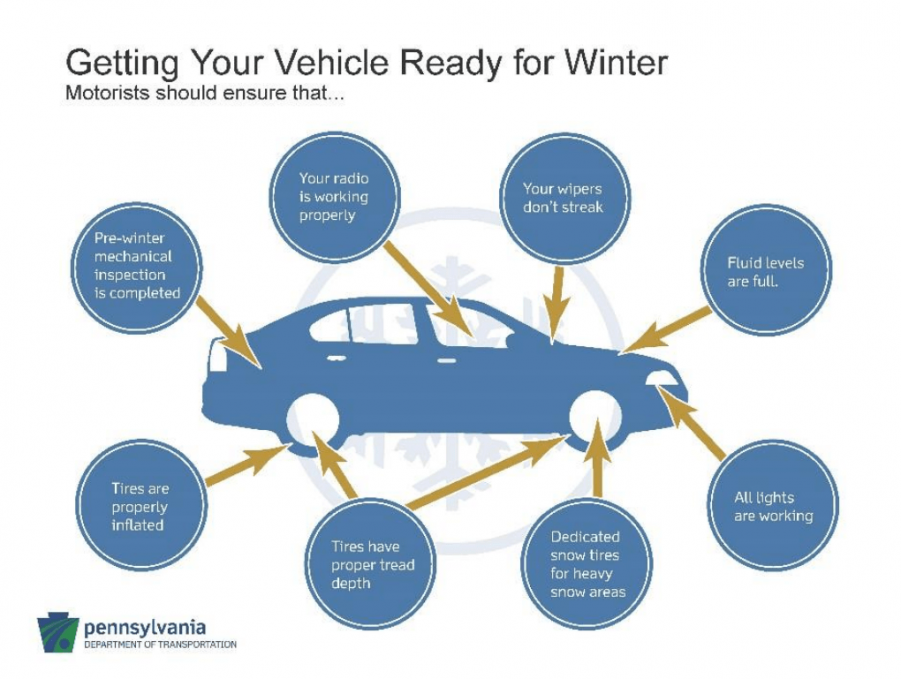5 Tips For Staying Safe While Driving In Inclement Weather
Driving in the winter poses unique challenges involving driving conditions and inclement weather. In Pennsylvania, car accidents due to challenging driving conditions are incredibly common in the winter with the amount of snow we receive. Just a little bit of snow or sleet can have catastrophic consequences for drivers on the road.
Even with unsafe roads, there are certain precautions that can be taken that greatly mitigate the chances of accidents. These tips can not only be used for your own safety, but for the safety of all drivers on the road when the weather is less than ideal.
As winter approaches, it’s important to go through a maintenance check:
Winter Driving Strategies
Follow these general driving strategies and you’ll be much safer in inclement weather. These strategies will greatly decrease your chance of getting into an accident in inclement weather.
- Increase following distance to at least 8-10 seconds
- DO NOT be overly confident in 4-wheel drive vehicles just because they can get through conditions easier, it does not mean they can stop in time
- Always decrease speed
- Use extra caution on bridges and overpasses
- Turn on headlights
- Avoid any fast or sharp movements
- Accelerate gently
- Turn slowly
- Brake carefully and early
Stopping Or Braking On Ice
When the road is icy, most accidents happen when drivers are unable to adequately brake. Knowing you can easily lose control of the car, to avoid accidents you have to change your approach to braking and coming to a stop. Here is a guide on how to brake on ice with ABS brakes.
- Maintain minimal pressure on the brakes
- Steer in the direction you want to go
- Do not shift into a lower gear
o Rear wheels may spin
o The car will travel sideways - If you begin to slide,
o Hold the steering wheel firmly
o Use very little motion to keep the car on the road or your car may begin to sway back and forth uncontrollably (Fishtail) - Do not over apply brakes
o If you feel the brake “pulse”, your antilock brakes are working
o If you do not feel the brakes “pulse” you should apply more pressure. - Accelerate the gas once you are off of the ice and the car is straight.
Sliding In The Snow
Sliding in the snow takes a slightly different course of action than sliding on ice. Here is what to do if you find yourself sliding in the snow.
- Do not slam on the brakes
- Ease off the accelerator
- Apply brakes gently
- Steer in the direction you want to go
- Be ready to correct in case you start to slide in the opposite direction
- Remain calm, do not overcorrect
Maintaining Traction In The Snow
There are a few things you can do in order to maintain traction, avoiding any issues when driving in the snow.
Automatic Transmission:
- Put the car in D2 and accelerate gently
- Shift car to D once the car is moving
Manual Transmission:
- Use a higher gear (2nd or 3rd) with which you can move the car without stalling
- Accelerate gently
Once you are moving:
- Try to keep wheels moving without spinning, slower speeds are essential to do this
- When driving downhill, shift to a lower gear to keep the car in control
Getting Stuck In The Snow
Sometimes, despite following all guidelines and doing everything in your power, the snow simply wins. If you ever find yourself stuck in the snow, here is what you can do to alleviate the situation.
- Put the car in park
o With the emergency brake on
o DO NOT turn the car off - Apply kitty litter or sand to the areas in front and in back of all tires
- Rock vehicle slightly
o Drive and Reverse
o Do not spin the wheels - Do not rev the engine above 35 mph
- Make sure no one is standing near the car as you attempt to move it
- If all else fails, call a tow truck







